1.链表的引入
由于在ArrayList任意位置插入或者删除元素时就需要将元素整体往前或者往后搬移,时间复杂度为O(n),效率比较低,因此ArrayList不适合在任意位置插入或者删除元素,因此引入了LinkedList,即链表结构。
2.链表的分类
2.1 单向或者双向
无头指每一个节点都可以存放数字
 2.2 带头或者不带头
2.2 带头或者不带头

2.3 循环或者非循环
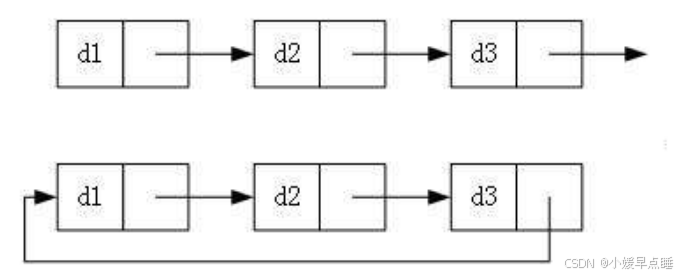
无头单向非循环结构简单,作为其他数据结构的子结构,在笔试面试中出现的比较多
 同时,无头双向循环链表,为LinkedList底层实现的链表。
同时,无头双向循环链表,为LinkedList底层实现的链表。

3.链表的实现(无头单项非循环)
import java.util.LinkedList;
public class MyLinkedList implements IList{
static class ListNode {
public int val;
public ListNode preV;
public ListNode next;
public ListNode(int val) {
this.val = val;
}
}
public ListNode head;//这里的head并不是指头而是方便取的名字
public ListNode last;
@Override
public void addFirst(int data) {
ListNode cur = head;
ListNode node = new ListNode(data);
if(head.next == null){
head = last = node;
}else{
node.next = cur;
cur.preV = node;
head = node;
}
}
@Override
public void addLast(int data) {
ListNode cur = head;
ListNode node = new ListNode(data);
if(head == null) {
head = last = node;
}else{
last.next = node;
node.preV = last;
last = node;
}
}
@Override
//在指定位置增删元素
public void addIndex(int index, int data) {
int len = size();
if(index < 0 || index > len ){
System.out.println("不符合条件");
return;
}if(index == 0){
addFirst(index);
return;
}if(index == len){
addLast(data);
return;
}else{
ListNode cur = findOfKey(index);
ListNode node = new ListNode(data);
node.next = cur;
node.preV = cur.preV;
cur.preV.next = node;
cur.preV = node;
}
}
private ListNode findOfKey(int index){
ListNode cur = head;
while(index != 0){
cur = cur.next;
index--;
}
return cur;
}
@Override
public boolean contains(int key) {
ListNode cur = head;
while(cur != null){
if(cur.val == key)
{
return true;
}
cur = cur.next;
}
return false;
}
@Override
public void remove(int key) {
ListNode cur = head;
while(cur != null) {
if (cur.val == key) {
if (cur == head) {
head = head.next;
if (head != null) {
head.preV = null;
}
} else {
cur.preV.next = cur.next;
if ( cur.next == null) {
last = last.preV;
}else {
cur.next.preV = cur.preV;
}
}
}
cur =cur.next;
}
}
@Override
public void removeAllKey(int key) {
ListNode cur = head;
while(cur != null) {
if (cur.val == key) {
if (cur == head) {
head = head.next;
if (head != null) {
head.preV = null;
}
}
else {
cur.preV.next = cur.next;
if (cur.next == null) {
last = last.preV;
}
cur.next.preV = cur.preV;
}
}
cur = cur.next;
}
}
@Override
public int size() {
ListNode cur = head;
int len = 0;
while(cur != null){
len++;
cur = cur.next;
}
return len;
}
@Override
public void clear() {
ListNode cur = head;
if(cur != null){
ListNode curN = cur.next;
cur.preV = null;
cur.next = null;
cur = curN;
}
head = null;
last = null;
}
@Override
public void display() {
ListNode cur = head;
while(cur != null){
System.out.print(cur.val+" ");
cur = cur.next;
}
System.out.println();
}接口:
public interface IList {
public void addFirst(int data);
public void addLast(int data);
public void addIndex(int index,int data);
public boolean contains (int key);
public void remove(int key);
public void removeAllKey(int key);
public int size();
public void clear();
public void display();
}4.链表面试题
4.1 移除链表元素
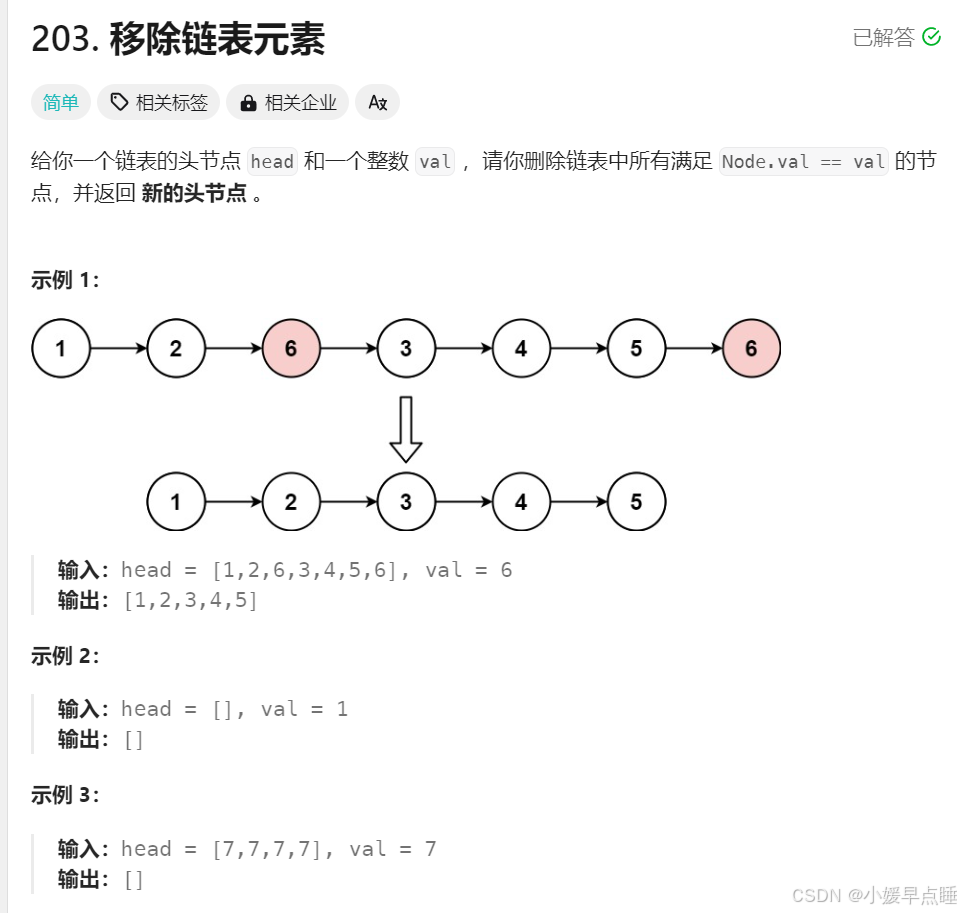
public class Solution {
public ListNode removeElements(ListNode head, int val) {
if(head == null){
return head;
}
ListNode pre = head;
ListNode cur = head.next;
while(cur != null){
if(cur.val == val){
pre.next = cur.next;
cur = cur.next;
}else{
pre = cur;
cur = cur.next;
}
}
if(head.val == val){
head = head.next;
}
return head;
}
}
4.2 反转链表
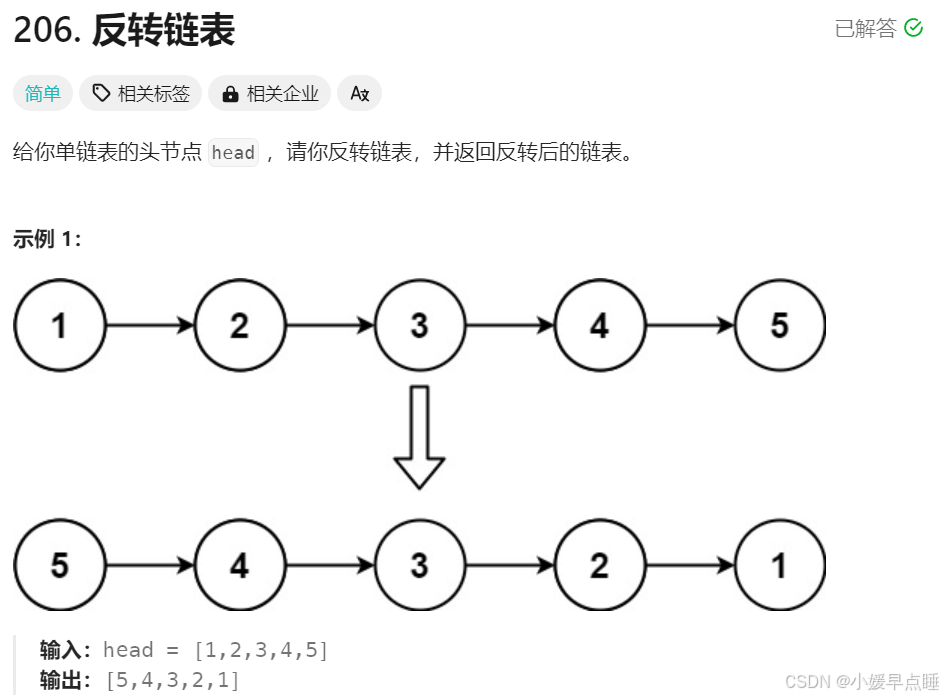
class Solution {
public ListNode reverseList(ListNode head) {
if(head == null){
return head;
}
ListNode cur = head.next;
head.next = null;
while(cur != null){
ListNode curN = cur.next;
cur.next = head;
head = cur;
cur = curN;
}
return head;
}
}4.3 链表的中间结点
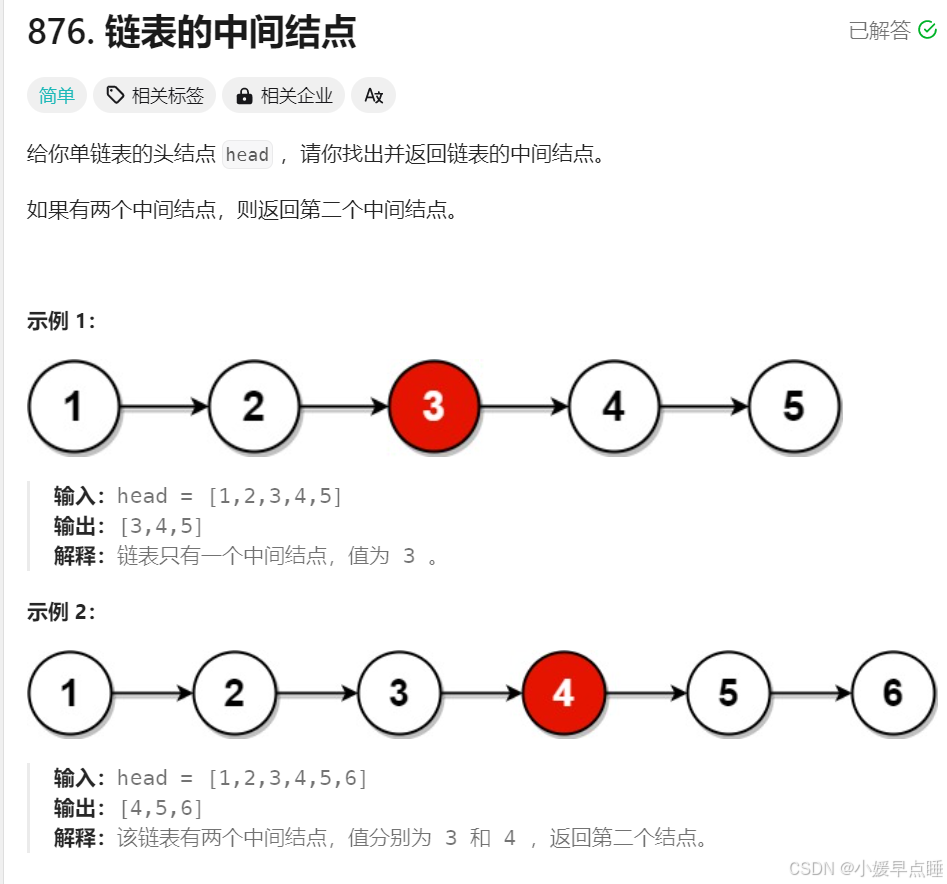
class Solution {
public ListNode middleNode(ListNode head) {
if(head == null){
return head;
}
ListNode fast = head;
ListNode slow = head;
while(fast != null && fast.next != null){
fast = fast.next.next;
slow = slow.next;
}
return slow;
}
}4.4 返回倒数第k个节点
/**
* Definition for singly-linked list.
* public class ListNode {
* int val;
* ListNode next;
* ListNode(int x) { val = x; }
* }
*/
class Solution {
public int kthToLast(ListNode head, int k) {
if(head == null){
return head.val;
}
ListNode fast = head;
ListNode slow = head;
int count = k - 1;
while(count != 0){
fast = fast.next;
count--;
}
while(fast.next != null){
fast = fast.next;
slow = slow.next;
}
return slow.val;
}
}4.5 合并两个有序链表
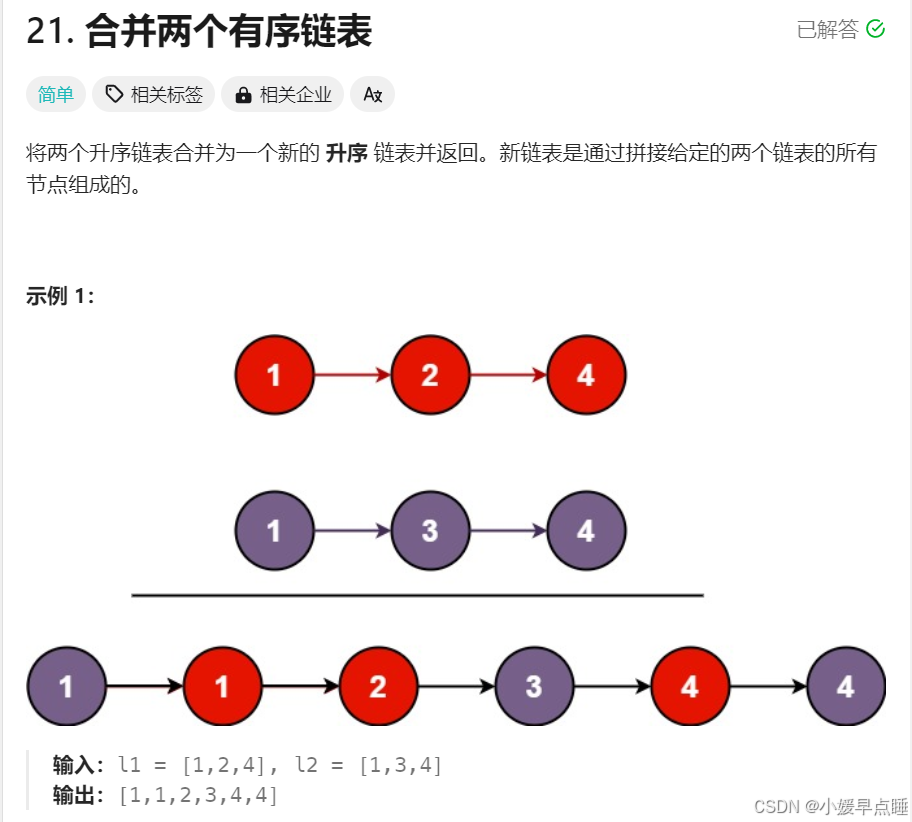
/**
* Definition for singly-linked list.
* public class ListNode {
* int val;
* ListNode next;
* ListNode() {}
* ListNode(int val) { this.val = val; }
* ListNode(int val, ListNode next) { this.val = val; this.next = next; }
* }
*/
class Solution {
public ListNode mergeTwoLists(ListNode list1, ListNode list2) {
ListNode newHead = new ListNode(-1);
ListNode tmp = newHead;
while(list1 != null && list2 != null){
if(list1.val <= list2.val){
tmp.next = list1;
list1 = list1.next;
tmp = tmp.next;
}else{
tmp.next = list2;
tmp = tmp.next;
list2 = list2.next;
}
}
if(list1 != null){
tmp.next = list1;
}
if(list2 != null){
tmp.next = list2;
}
return newHead.next;
}
}4.6 链表分割
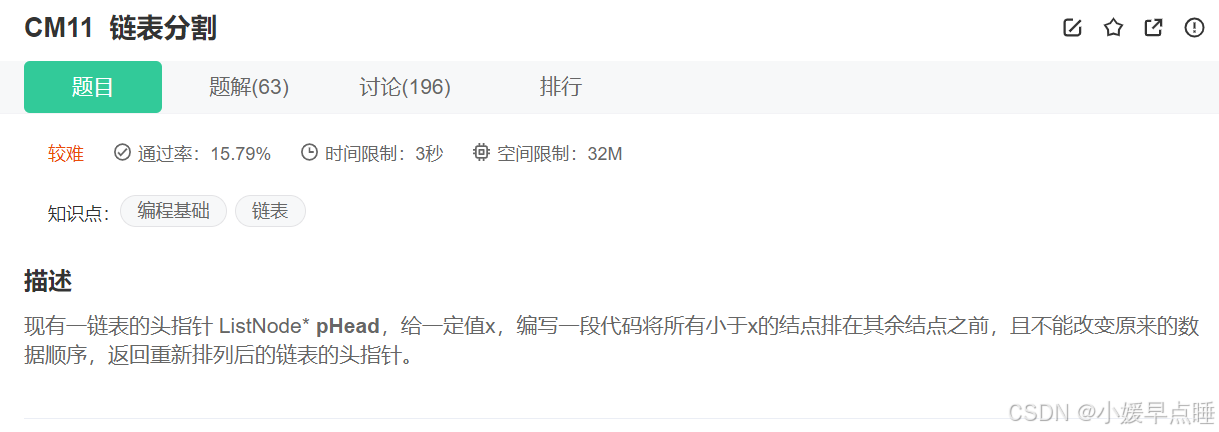
public class Partition {
public ListNode partition(ListNode pHead, int x) {
ListNode as = null;
ListNode ae = null;
ListNode bs = null;
ListNode be = null;
ListNode cur = pHead;
while(cur != null){
if(cur.val < x){
if(as == null){
as = ae = cur;
}else{
ae.next = cur;
ae = ae.next;
}
}else{
if(bs == null){
bs = be =cur;
}else{
be.next = cur;
be = be.next;
}
}
cur = cur.next;
}
if(as == null){
return bs;
}
ae.next = bs;
if(bs != null){
be.next = null;
}
return as;
}
}4.7 链表回文

public class PalindromeList {
public boolean chkPalindrome(ListNode A) {
if(A == null){
return false;
}
// write code here
ListNode fast = A;
ListNode slow = A;
while(fast != null && fast.next != null){
fast = fast.next.next;
slow = slow.next;
}
ListNode cur = slow.next;
while(cur != null){
ListNode curN = cur.next;
cur.next = slow;
slow = cur;
cur = curN;
}
while(A != slow){
if(A.val != slow.val){
return false;
}
if(A.next == slow){
return true;
}
A= A.next;
slow = slow.next;
}
return true;
}
}4.8 相交链表
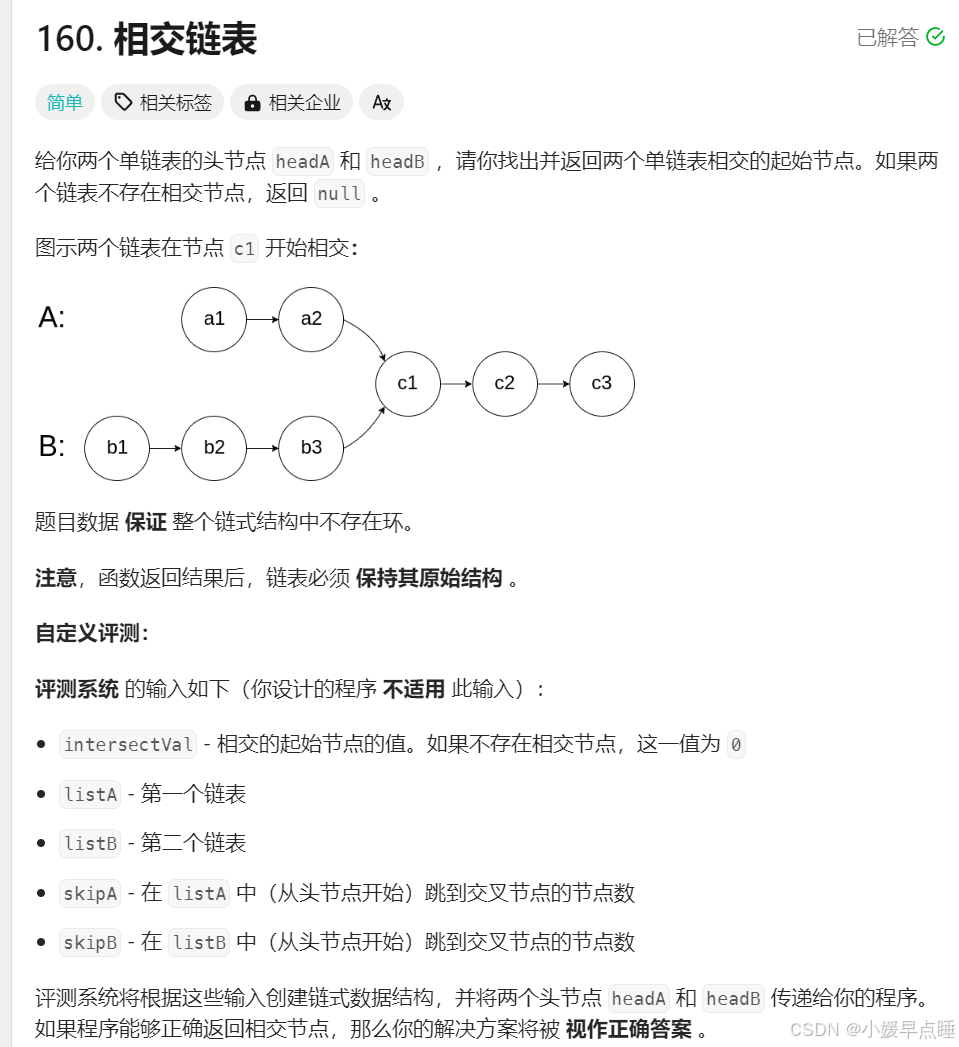
public class Solution {
public ListNode getIntersectionNode(ListNode headA, ListNode headB) {
ListNode pl = headA;
ListNode ps = headB;
int lenA = 0;
int lenB = 0;
//计算长度
while(pl != null){
lenA++;
pl = pl.next;
}
while(ps != null){
lenB++;
ps = ps.next;
}
pl = headA;
ps = headB;
//计算两个链表的差值
int len = lenA - lenB;
if(len < 0){
pl = headB;
ps = headA;
len = lenB - lenA;
}
while(len != 0){
pl = pl.next;
len--;
}
while(pl != ps){
pl = pl.next;
ps = ps.next;
}
if(pl == null){
return null;
}
return pl;
}
}4.9 环形链表
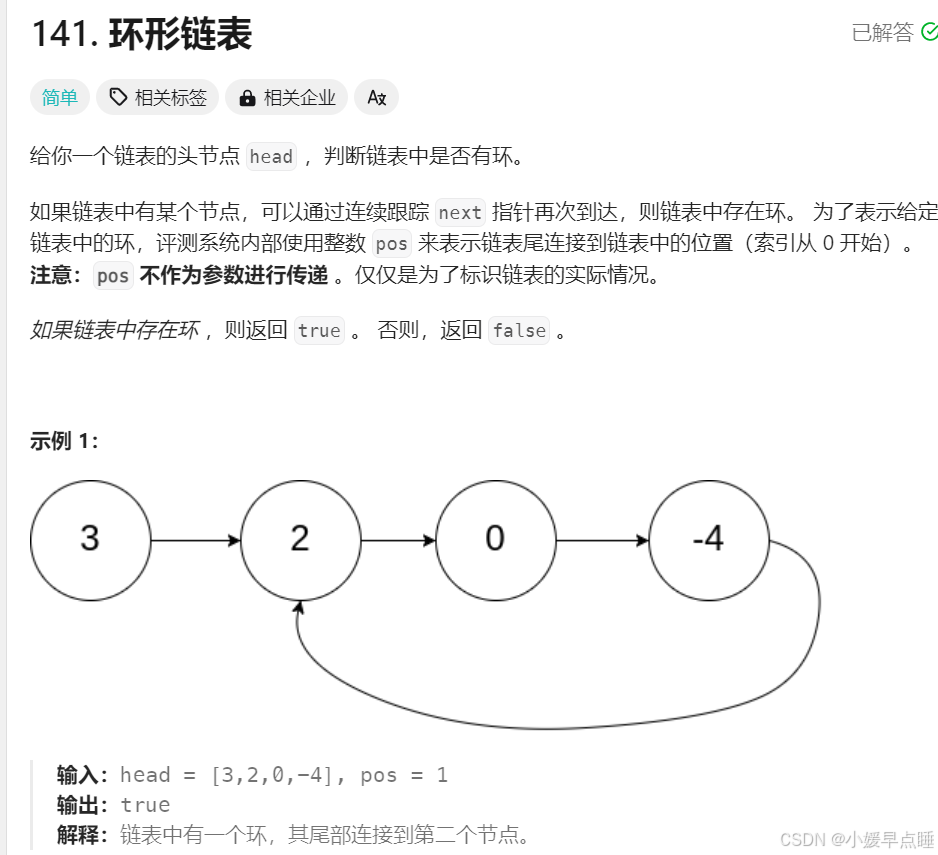
public class Solution {
public boolean hasCycle(ListNode head) {
ListNode fast = head;
ListNode slow = head;
while(fast != null && fast.next != null){
fast = fast.next.next;
slow = slow.next;
if(fast == slow ){
return true;
}
}
return false;
}
}5.双向链表的基本实现(LinkedList)
public class MyLinkedList implements IList{
static class ListNode {
public int val;
public ListNode preV;
public ListNode next;
public ListNode(int val) {
this.val = val;
}
}
public ListNode head;
public ListNode last;
@Override
public void addFirst(int data) {
ListNode cur = head;
ListNode node = new ListNode(data);
if(head.next == null){
head = last = node;
}else{
node.next = cur;
cur.preV = node;
head = node;
}
}
@Override
public void addLast(int data) {
ListNode cur = head;
ListNode node = new ListNode(data);
if(head == null) {
head = last = node;
}else{
last.next = node;
node.preV = last;
last = node;
}
}
@Override
//在指点位置增删元素
public void addIndex(int index, int data) {
int len = size();
if(index < 0 || index > len ){
System.out.println("不符合条件");
return;
}if(index == 0){
addFirst(index);
return;
}if(index == len){
addLast(data);
return;
}else{
ListNode cur = findOfKey(index);
ListNode node = new ListNode(data);
node.next = cur;
node.preV = cur.preV;
cur.preV.next = node;
cur.preV = node;
}
}
private ListNode findOfKey(int index){
ListNode cur = head;
while(index != 0){
cur = cur.next;
index--;
}
return cur;
}
@Override
public boolean contains(int key) {
ListNode cur = head;
while(cur != null){
if(cur.val == key)
{
return true;
}
cur = cur.next;
}
return false;
}
@Override
public void remove(int key) {
ListNode cur = head;
while(cur != null) {
if (cur.val == key) {
if (cur == head) {
head = head.next;
if (head != null) {
head.preV = null;
}
} else {
cur.preV.next = cur.next;
if ( cur.next == null) {
last = last.preV;
}else {
cur.next.preV = cur.preV;
}
}
}
cur =cur.next;
}
}
@Override
public void removeAllKey(int key) {
ListNode cur = head;
while(cur != null) {
if (cur.val == key) {
if (cur == head) {
head = head.next;
if (head != null) {
head.preV = null;
}
}
else {
cur.preV.next = cur.next;
if (cur.next == null) {
last = last.preV;
}
cur.next.preV = cur.preV;
}
}
cur = cur.next;
}
}
@Override
public int size() {
ListNode cur = head;
int len = 0;
while(cur != null){
len++;
cur = cur.next;
}
return len;
}
@Override
public void clear() {
ListNode cur = head;
if(cur != null){
ListNode curN = cur.next;
cur.preV = null;
cur.next = null;
cur = curN;
}
head = null;
last = null;
}
@Override
public void display() {
ListNode cur = head;
while(cur != null){
System.out.print(cur.val+" ");
cur = cur.next;
}
System.out.println();
}
//在指定位置进行打印
public void display2(ListNode newHead) {
ListNode cur = head;
while (cur != null) {
System.out.print(cur.val + " ");
cur = cur.next;
}
System.out.println();
}
public ListNode reverseList() {
if(head == null){
return head;
}
ListNode cur = head.next;
head.next = null;
while(cur != null){
ListNode curN = cur.next;
cur.next = head;
head = cur;
cur = curN;
}
return head;
}
}5.1LinkedList的一些性质
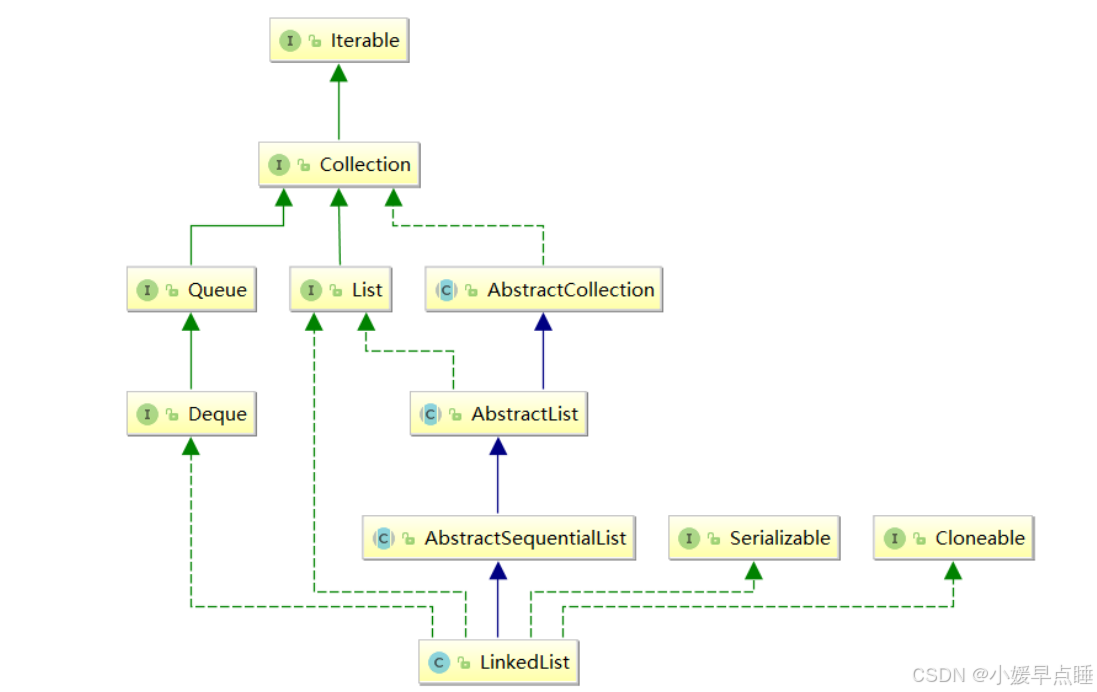

 5.2 LinkedList的使用
5.2 LinkedList的使用

2 其他方法的使用
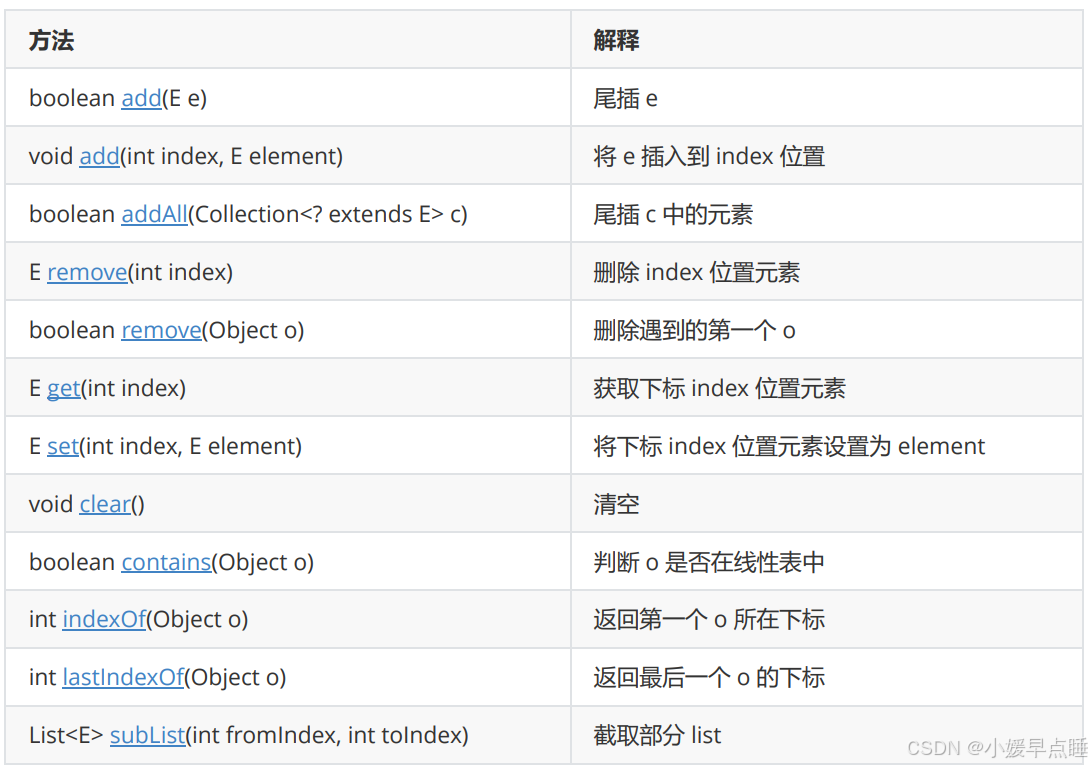


3 LinkedList的遍历
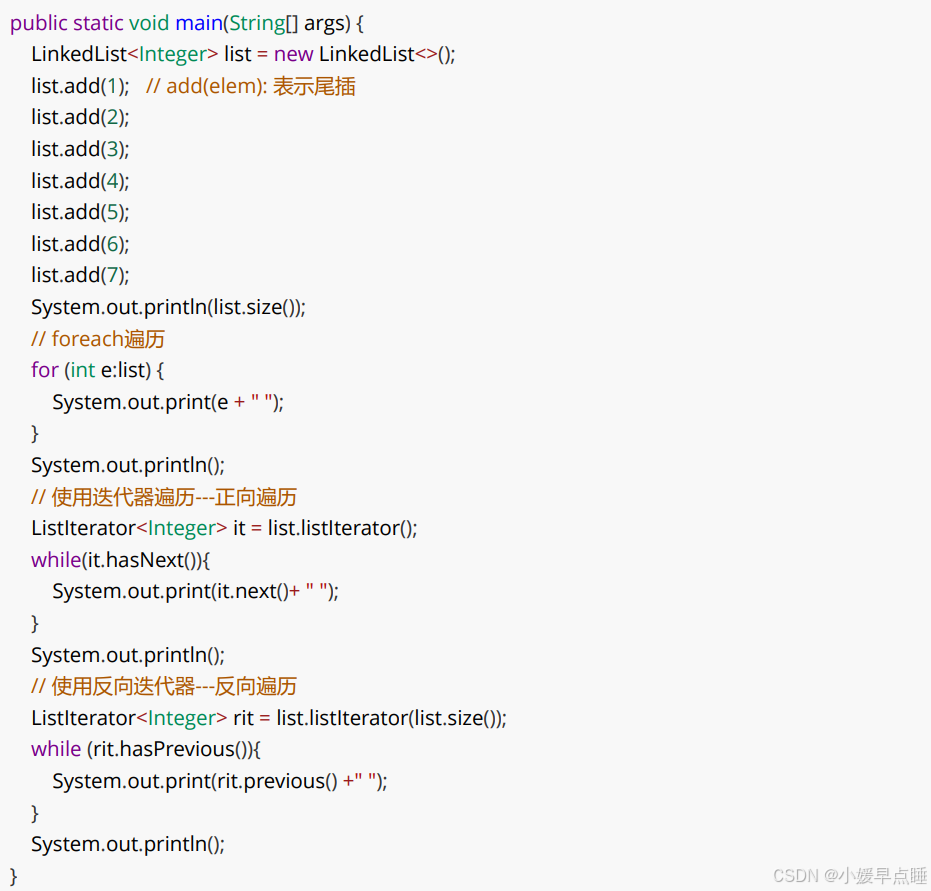
6.ArrayList 与 LinkedList的区别

























 554
554

 被折叠的 条评论
为什么被折叠?
被折叠的 条评论
为什么被折叠?








